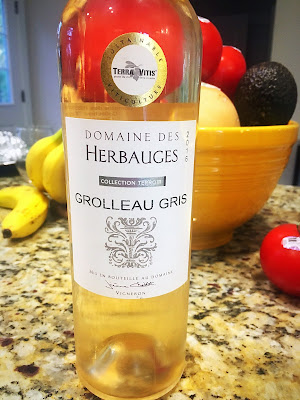
This week I tried a bottle of Grolleau Gris that my fiance picked up at Wine Authorities. Grolleau Gris is a very hard to find grape variety. The grape comes from the Loire Valley in France, and it's actually a mutation of the Grolleau Noir grape. Instead of the rich dark skin of the Grolleau Noir grap, Gralleau Gris is pink-skinned. The Noir grape is most commonly blended with Gamay and used to make rose, while the Gris grape is used to make whites.
The grape comes from the Loire Valley. Wine has been grown and made in that region since the First Century. It's directly north of Cognac and west of Burgundy, so it's surrounded by other great wine regions. The Loire Vally can be broken up into three growing sections: Pays Nantais (the lower region); Anjou, Saumur, and Touraine (the middle region); and Centre (the upper region). This Grolleau Gris came from the Pays Nantain, where the most common grapes grown are Muscadet, Pinot Gris, and Folle Blanche. The area if very close to the Atlantic Ocean, and the climate is similar to that in the United States' Pacific Northwest. The soil in the Pays Nantain is mostly volcanic, which can affect the minerality of the wine.

Now I'm sure your wondering what this hard to find white wine actually tastes like. This wine is an incredibly dynamic wine. It completely changed out it tasted and smelled after one hour of being open, and the next day I couldn't believe that it was even the same wine because it had changed even more!
With my first sniff of the wine I got light citrus notes, clean minerality, and a hint of freshly cut grass. When I tasted it there was a delightful crispness. The citrus note came out stronger as grapefruit with a hint of underripe apricot, the minerality was like slate, and the fresh grass note was accompanied by a note of fresh herbs. It was the kind of crisp white wine that I really enjoy in the summer, similar to a Sauvignon Blanc from the Loire Valley. When I poured myself a few more sips of the wine about 45 minutes later, it tasted a little different. It was still identifiable as the same wine, but it had lost some of its crispness and had gotten a touch sweeter. The apricot note got stronger and overtook the grapefruit note a bit and the minerality had mellowed out a bit. When I poured myself a glass of the wine the next day, it tasted like a completely different wine. It was much sweeter and not very crisp at all. The grapefruit note was basically entirely gone, and a syrupy peach note had overtaken the apricot, and it was much chalkier. I really liked the wine when I first opened it, but it was too sweet for me the second day. If I buy it again I'll be sure to drink it with friends and finish it in one sitting.


I paired this wine the first night with grilled salmon and vegetable skewers, with a garlic and parsley butter marinade. The wine and the food went so well together. The crispness played well off of the grilled zucchini and the citrus grapefruit and apricot went well with the salmon. The second night, I had a glass of the wine while I was cooking, so I didn't really pair it with anything. However, once it was sweeter and less crisp the second day, I would almost recommend using this as kind of a mild dessert wine, it's not as syrupy as actual dessert wines, but it would go well with a slice of apple pie or a creme brulee.


No comments:
Post a Comment